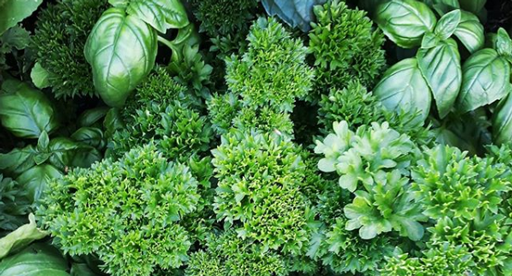
5 Steps to Herb Planting Success
- Choose a spot outside that is close to your kitchen, or put pots on a sunny windowsill inside, for easy access.
- Prepare your soil with organic matter like compost and sheep pellets.
- Add a layer of herb mix to plant into. Herbs can be grown year-round in New Zealand - choose options suited to the time of year.
- Feed herbs regularly to promote green leafy growth.
- Pick and water your herbs regularly.
Follow our full guide below to a bumper crop of homegrown herbs.
Fragrant herbs will add a flavour punch to any meal, particularly when they are freshly snipped from your own garden. Plant in your garden beds, pots and containers, and you’ll be harvesting a bumper crop of homegrown herbs this season. Get our guide to growing garden-fresh herbs below.
Prepare
Choose a spot outside that is close to your kitchen, or put pots on a sunny windowsill inside, for easy access. Next choose your herb plants. There are a large variety of herbs to choose from based on your taste and cooking preferences.
Like building a house a good foundation is the key to success in your garden. The better the soil, the better your plants will grow. If you are starting with an existing garden bed dig in organic matter like Tui Sheep Pellets and Tui Compost to your soil.
Then you can add a layer of Tui Herb Mix, a free draining planting mix, rich in nitrogen to promote green, leafy growth and continuous harvesting. If planting in pots and containers, fill with Tui Herb Mix.
Plant
If you’re a first time gardener you may find it easier to grow from seedlings, rather than seeds, although seeds are a more economical option. Some herbs are best grown from seed in your garden or pots, such as coriander and parsley. Check seed packets or plant labels for individual planting instructions.
The best times to plant are early in the morning or late in the day, so the plants aren’t exposed to the hot sun straight away.
Don’t be shy when planting herbs as they quite like close neighbours, and you can always plant herbs in between other plants as they make great space fillers and companion plants.
Directions for planting in garden beds:
- Soak your seedlings in a bucket of Tui Organic Seaweed Plant Tonic before planting and allow to drain. This will help prevent transplant shock and give your herbs a healthy start.
- Add a layer of Tui Herb Mix to the planting area.
- Dig a hole, approximately twice the depth and width of the root ball of your plant.
- Gently loosen the root ball of your plant and position in the centre of the hole.
- Fill in with Tui Herb Mix.
- Press soil gently around the base of the plant.
- Water your plant well and continue to water regularly.
Directions for planting in pots and containers:
- If your container has no drainage holes, add stones to the bottom of the container to act as drainage.
- Soak your seedlings in a bucket of Tui Organic Seaweed Plant Tonic before planting and allow to drain. This will help prevent transplant shock and give your herbs a healthy start.
- Half fill your container with Tui Herb Mix.
- Gently take the plant from the current container, loosen the root ball and remove any loose or dead plant material and roots.
- Position the plant in the centre of the new container and fill with Tui Herb Mix up to 3cm from the top.
- Gently firm mix around the base of the plant. The mix should be at the same level on the plant as it was in the previous container.
- Water your plant well and continue to water regularly.
Nourish
Feed your herbs and they will feed you. Plants use nutrients from the soil as they grow, so replenishing the nutrients ensures your plants grow to their full potential. Feed your herbs with Tui NovaTec Premium fertiliser.
Well watered, well nourished herbs will have a better chance of keeping insect pests and diseases at bay.
Tui Tips:
For novice gardeners a few herbs grown in pots can be the perfect introduction to the joys of ‘growing your own’. For those more experienced gardeners, get inspired in the kitchen and try growing different herbs that suit your culinary style.
- Most herbs in pots can be grown indoors and outdoors – choose a sunny windowsill when growing indoors.
- Take care not to overwater your herbs as they don’t like to sit in soggy soil.
- If you want to try something different, plant a combination of Vietnamese mint, Thai basil and lemongrass – all wonderful additions to Asian cooking.
- Over summer some herbs like coriander, parsley and basil are prone to go to seed. To avoid, water your herbs consistently, regularly pick, remove flowers and remove parts of the plant that go to seed.
- Pick fresh herbs and add to your salad or stir-fry.
- If you have an excess of herbs, chop them up and freeze them in ice cubes – these can then be used in drinks and meals later in the year. Mint is especially good for this.
- Hyssop deters white butterfly from brassicas like cabbages and Brussels sprouts.
- Basil improves the flavour of tomatoes when planted alongside.
- Some herbs tend to take over the garden once planted like mint. To avoid, plant in pots rather than garden beds.
- Jan
- Feb
- Mar
- Apr
- May
- Jun
- Jul
- Aug
- Sep
- Oct
- Nov
- Dec
- Harvest in 30-45 days
Shopping list
- Tui Herb Mix
- Tui Organic Seaweed Plant Tonic
- Tui Compost
- Tui Sheep Pellets
- Tui NovaTec Premium Fertiliser
Download a printable PDF herb guide here